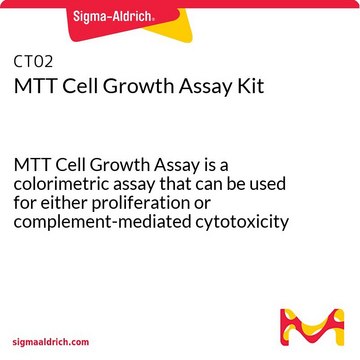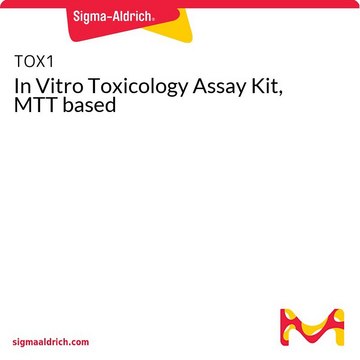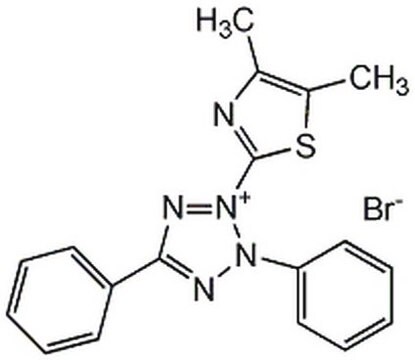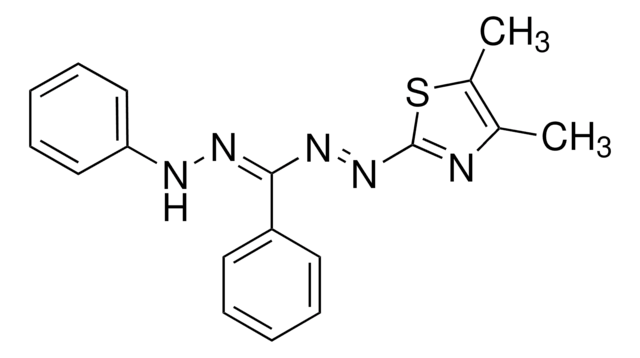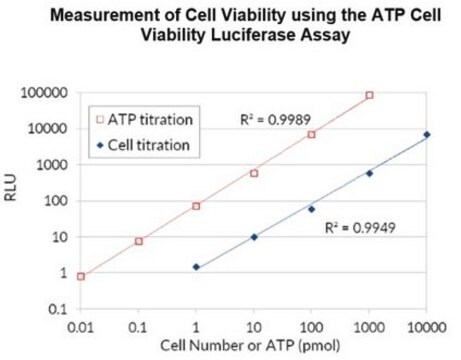推薦產品
一般說明
MTT is a pale yellow substrate that is cleaved by living cells to yield a dark blue formazan product. This process requires active mitochondria, and even freshly dead cells do not cleave significant amounts of MTT. The colorimetric assay described below can be used for either proliferation or complement-mediated cytotoxicity assays.
應用
Procedure:
1. Carry out a lymphokine, mitogen, or complement-mediated cytotoxicity assay using standard methods, in 96-well flat-bottomed tissue culture plates of good optical quality (e.g. Falcon). The final volume of tissue culture medium in each well should be 0.1 mL, and the medium (e.g. RPMI or DMEM) may contain up to 10% Fetal Bovine Serum.
2. At the end of the assay add 0.01 mL AB Solution (MTT) to each well. Mix by tapping gently on the side of the tray.
3. Incubate at 37°C for cleavage of MTT to occur. Optimal times may vary according to the assay, but four hours is suitable for most purposes. At the end of this time, the MTT formazan produced in wells containing live cells will appear as black, fuzzy crystals on the bottom of the well.
4. Add 0.1 mL isopropanol with 0.04 N HCl to each well. Mix thoroughly by repeated pipetting with a multichannel pipettor. The HCl converts the phenol red in tissue culture medium to a yellow color that does not interfere with MTT formazan measurement. The isopropanol dissolves the formazan to give a homogeneous blue solution suitable for absorbance measurement.
5. Within an hour, measure the absorbance on an ELISA plate reader with a test wavelength of 570 nm and a reference wavelength of 630 nm. After several hours at room temperature, serum proteins may begin to precipitate due to the acid/alcohol. Chilling the plates will hasten the precipitation. If the plates must be stored before measuring, keep at 4° C before adding the acid/alcohol, then warm to room temperature and add acid/alcohol just before reading.
Results:
The MTT assay will normally detect 200 to 50,000 cells of a typical cell line, although 1,000 to 50,000 is the useful range. This number may vary for other cell types. Cytotoxic assays should be set up so that the control, unlysed cells give a signal of 0.2 to 0.4, and proliferation assays should yield a similar value at plateau concentrations. This corresponds to about 20-50,000 cells per well with a typical cell line.
Absorbance is directly proportional to the number of cells; actual cells do not absorb significantly, even up to concentrations of 1 x 106 cells/mL.
1. Carry out a lymphokine, mitogen, or complement-mediated cytotoxicity assay using standard methods, in 96-well flat-bottomed tissue culture plates of good optical quality (e.g. Falcon). The final volume of tissue culture medium in each well should be 0.1 mL, and the medium (e.g. RPMI or DMEM) may contain up to 10% Fetal Bovine Serum.
2. At the end of the assay add 0.01 mL AB Solution (MTT) to each well. Mix by tapping gently on the side of the tray.
3. Incubate at 37°C for cleavage of MTT to occur. Optimal times may vary according to the assay, but four hours is suitable for most purposes. At the end of this time, the MTT formazan produced in wells containing live cells will appear as black, fuzzy crystals on the bottom of the well.
4. Add 0.1 mL isopropanol with 0.04 N HCl to each well. Mix thoroughly by repeated pipetting with a multichannel pipettor. The HCl converts the phenol red in tissue culture medium to a yellow color that does not interfere with MTT formazan measurement. The isopropanol dissolves the formazan to give a homogeneous blue solution suitable for absorbance measurement.
5. Within an hour, measure the absorbance on an ELISA plate reader with a test wavelength of 570 nm and a reference wavelength of 630 nm. After several hours at room temperature, serum proteins may begin to precipitate due to the acid/alcohol. Chilling the plates will hasten the precipitation. If the plates must be stored before measuring, keep at 4° C before adding the acid/alcohol, then warm to room temperature and add acid/alcohol just before reading.
Results:
The MTT assay will normally detect 200 to 50,000 cells of a typical cell line, although 1,000 to 50,000 is the useful range. This number may vary for other cell types. Cytotoxic assays should be set up so that the control, unlysed cells give a signal of 0.2 to 0.4, and proliferation assays should yield a similar value at plateau concentrations. This corresponds to about 20-50,000 cells per well with a typical cell line.
Absorbance is directly proportional to the number of cells; actual cells do not absorb significantly, even up to concentrations of 1 x 106 cells/mL.
MTT Cell Growth Assay is a colorimetric assay that can be used for either proliferation or complement-mediated cytotoxicity assays.
成分
Reagent A: MTT, (3-(4,5-dimethylthiazol-2-yl)-2,5-diphenyl tetrazolium bromide), 50 mg/vial.
Solution B: PBS pH 7.4, 60 mL
Solution B: PBS pH 7.4, 60 mL
儲存和穩定性
Maintain at 2-8°C for up to six months. The Reagent A / Solution B mixture is stable at 2-8°C for up to two weeks.
Reagent Preparation:
For every 1,000 assays to be performed, add 10 mL Solution B to one vial of Reagent A. Mix well, sterile filter and keep in the dark at 4° C until used. Note: It may take overnight to dissolve. Do not heat solution. When absolutely required to dissolve crystals, adjust pH with 1-2 drops of HCl. The AB mixture is stable for several weeks under these conditions.
Reagent Preparation:
For every 1,000 assays to be performed, add 10 mL Solution B to one vial of Reagent A. Mix well, sterile filter and keep in the dark at 4° C until used. Note: It may take overnight to dissolve. Do not heat solution. When absolutely required to dissolve crystals, adjust pH with 1-2 drops of HCl. The AB mixture is stable for several weeks under these conditions.
法律資訊
CHEMICON is a registered trademark of Merck KGaA, Darmstadt, Germany
免責聲明
Unless otherwise stated in our catalog or other company documentation accompanying the product(s), our products are intended for research use only and are not to be used for any other purpose, which includes but is not limited to, unauthorized commercial uses, in vitro diagnostic uses, ex vivo or in vivo therapeutic uses or any type of consumption or application to humans or animals.
訊號詞
Warning
危險分類
Eye Irrit. 2 - Muta. 2 - Skin Irrit. 2 - STOT SE 3
標靶器官
Respiratory system
儲存類別代碼
10 - Combustible liquids
分析證明 (COA)
輸入產品批次/批號來搜索 分析證明 (COA)。在產品’s標籤上找到批次和批號,寫有 ‘Lot’或‘Batch’.。
客戶也查看了
Tianxiang Chen et al.
Thoracic cancer, 10(4), 930-941 (2019-03-19)
Osimertinib (AZD9291), a third-generation EGFR-tyrosine kinase inhibitor, can effectively prolong survival in non-small cell lung cancer (NSCLC) patients with EGFR mutations, particularly T790M mutations; however, acquired resistance to AZD9291 is inevitable, thus exploration of the targets of resistance is urgent.
May Khanna et al.
The Journal of biological chemistry, 286(50), 43486-43494 (2011-10-25)
Human aldehyde dehydrogenases (ALDHs) comprise a family of 17 homologous enzymes that metabolize different biogenic and exogenic aldehydes. To date, there are relatively few general ALDH inhibitors that can be used to probe the contribution of this class of enzymes
Binhao Zhang et al.
Oncology reports, 35(3), 1807-1815 (2015-12-10)
5-Fluorouracil (5-FU), a cell cycle-specific antimetabolite, is one of the most commonly used chemotherapeutic agents for colorectal cancer (CRC). Yet, resistance to 5-FU-based chemotherapy is still an obstacle to the treatment of this malignancy. Mutation or loss of Smad4 in
Adrián Vilalta et al.
Human gene therapy, 16(10), 1143-1150 (2005-10-13)
Preclinical studies were conducted in mice and rabbits to evaluate biodistribution/persistence and potential integration of plasmid DNA (pDNA) after intramuscular administration of a poloxamer-formulated pDNAbased vaccine, VCL-CT01, encoding gB, pp65, and IE1 human cytomegalovirus (hCMV) immunogens. Tissue distribution in mice
Characterization of a novel rat cholangiocarcinoma cell culture Model-CGCCA.
Yeh CN, Lin KJ, Chen TW, Wu RC, Tsao LC, Chen YT, Weng WH, Chen MF
World Journal of Gastroenterology null
文章
Serum-free defined cancer stem cell media used to grow and expand cancer cells in 3D tumorsphere aggregates.
Cell based assays for cell proliferation (BrdU, MTT, WST1), cell viability and cytotoxicity experiments for applications in cancer, neuroscience and stem cell research.
我們的科學家團隊在所有研究領域都有豐富的經驗,包括生命科學、材料科學、化學合成、色譜、分析等.
聯絡技術服務
